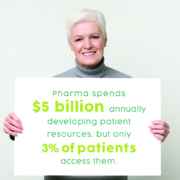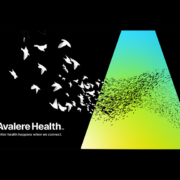Ad-ventures in Marketing XVI
Ad-ventures in Marketing XVI
For the sixteenth year, MedAdNews has chosen a group of new Pharmaceutical Marketing Ventures to Watch that could change the way pharmaceutical products are marketed and sold.
By Joshua Slatko • [email protected]
This past October, the Med Ad News team began its annual search for the future of pharmaceutical marketing. We sought out young companies, spin-offs, offerings, and ventures to profile that are providing the most innovative and interesting products, services, and marketing opportunities to pharma brands and the lifesciences community. As might be expected, this year’s selections are all technology-focused, but they also share another key characteristic: the efficient use of data to break down the walls between information and those that need it. Here are Med Ad News’ newest Pharmaceutical Marketing Ventures to Watch.
POCN

POCN is an online community of nurse practitioners and physician assistants that enables lifesciences brands to communicate these important caregivers on their own terms.
POCN, the Point of Care Network, is an online community of nearly 400,000 nurse practitioners and physician assistants that enables its users to review clinical and industry news, find earning opportunities, network with each other, and access resources to improve patient outcomes. Pharma brands and companies are able to partner with POCN to access its members via what the company calls, “Data-optimized strategies and digital marketing solutions that identify, reach, and engage these important clinicians on their terms.” The company is able to offer its partners detailed insights into each user, including inferred specialties, affiliations, geolocations, and the other NPs and PAs that they mentor, allowing for precise targeting and tracking of prescriptions at the actual prescriber level. Additionally, POCN maintains an Ambassador Network of more than 5,000 vetted NPs and PAs segmented by influencer status, platform use, geographic reach, and area of expertise.
“When I started the company in 2014, I was operating on the premise that NPs and PAs were super important but misunderstood and underappreciated by pharma,” Richard Zwickel, POCN’s CEO and founder, told Med Ad News. “So the opportunity we’ve been chasing ever since has been to help pharma and lifesciences companies recognize the valuable and influential work that NPs and PAs do. We’ve built a place where NPs and PAs can learn, earn, care, and connect. And the numbers of both users and lifesciences partners have just skyrocketed; about 90 percent of all NPs and PAs have opted into our community, and we’re working with close to 50 clients.”
Perhaps the most critical discovery that POCN has made along the way, at least from a lifesciences brand perspective, is that a great deal of what brands think they know about the crediting of prescriptions might just be wrong.
“With a community of NPs and PAs this large, we’ve been able to use our data and our algorithms to show that our users are writing many, many prescriptions that are or previously would’ve been credited to doctors,” Zwickel explains. “So we’ve built a model that has been able to prove a lot of misattributions in prescriptions.”
This sometimes comes as a surprise to pharma brand managers. “We recently met with a large vaccine company, and they didn’t really understand that the NP and PA Rx for their vaccine was worth roughly $250 million in prescriptions, and the space where they were trying to go with their new product has roughly 40 percent NP and PA prescriptions in that space,” Zwickel says.
The path to POCN began when Zwickel was working at the Physicians’ Desk Reference and later as an early employee of the physicians’ network QuantiaMD. “At PDR we had a relationship with the AANP and the AAPA, and I reached out and convinced them to sponsor our CD-ROM,” he says. “Later, at QuantiaMD, I discovered that even though it was a community for physicians, we were seeing NPs and PAs on there, too.” So the idea was to borrow some of the concepts behind QuantiaMD – the online community, the social connectivity, the ambassadors, the data, the whole idea of influencer marketing – and translate them into the world of NPs and PAs, so they could have their own space and lifesciences partners could have a way to reach them in that space. “And we named it POCN, the Point of Care Network, because NPs and PAs are on the front lines of care.”
Sitting on top of this community and all the data it produces, POCN is able to offer a variety of NP- and PA-focused services to its lifesciences clients. TotalOffice identifies NPs and PAs sharing a practice with existing brand targets and deciles them by patient volume. Inferred Specialty examines claims data to infer an NP or PA’s specialty focus based on the conditions they treat. TrueRx matches prescriptions back to the actual NP/PA decision makers when those prescriptions are being reported under the umbrella of an affiliated MD, enabling both targeting and post-campaign attribution. The company’s Virtual Ad Boards enables virtual encounters to uncover opinions and input from high-potential NPs and PAs with the client’s core strategy in mind – those NPs and PAs can then offer recommendations for identifying appropriate campaign targets. POCN can also work with clients to identify local, regional, and national-level KOL NPs and PAs for use across a brand’s geographic and therapeutic strategies.
“What we’ve been able to do is work with clients to help them build a strategy, help them understand the data regarding who the prescriber really is, who is really making the decisions, where their data might include misattributions,” Zwickel says. “Then we essentially build out strategic components that allow the client to go out and really have an impact on NPs and PAs in their space. This means everything from doing ad boards and helping them understand the data to building out fully orchestrated engagement strategies on our platforms.”
Note the plural in “platforms.” POCN goes beyond its NP/PA online community by also offering POCN+, an over-the-top streaming video service providing free live and on-demand educational content for NPs and PAs, through which partners can sponsor channels with their own or other related content. Clients can also use the company’s PeerCast messaging service to send specialized content directly to targeted NPs and PAs. And POCN’s virtual and live events can deliver information to NPs and PAs in an interactive setting tweaked for geolocation, therapeutic area, and any other targeting variables.
“We really want to educate the market,” Zwickel says. “We don’t have a lot of competition in this space. We’re able to reach these folks based on how they practice, where they went to school, what their patient panel looks like, whether they work at a hospital or a traditional practice or an urgent care across multiple locations. We reach NPs and PAs on their own terms, and that’s why we’ve been able to help our clients do the same.”
One of the most critical insights that POCN is able to provide to lifesciences clients is the inferred specialties of its users. “An NP might be in a primary care practice but is mostly seeing and prescribing for migraine and neurology patients,” Zwickel explains. “Our clients have really taken to that because so many NPs and PAs do work in primary care, but we know which ones are treating diabetes. We know which ones are treating Alzheimer’s. Or someone is in a cardiovascular practice, but they’re the one managing most of the heart failure patients, or they’re in a gastro practice, and they’re seeing a lot of the patients for colonoscopy management. We have all that data, so we can help clients communicate to NPs and PAs in the proper lane rather than just spray and pray.”
And POCN happens to be on a train that is speeding up. According to AANP there are more than 385,000 nurse practitioners licensed in the United States today, and the Bureau of Labor Statistics estimates that their numbers will grow by more than 50 percent between 2020 and 2030. According to NCCPA, the number of certified physician assistants in the United States grew by 76 percent between 2013 and the end of last year. And according to a study published last year by the American Association of Medical Colleges, the United States will be facing a shortage of between 38,000 and 124,000 physicians by 2034, which means that the roles of NPs and PAs in providing care will grow even more critical.
“We appreciate and enjoy the relationships we have with agencies and media players, and there’s nothing like sitting with a client and explaining to them how valuable this audience is to them,” Zwickel told Med Ad News. “We’re really able to shine a light on the prescriptions that are coming from NPs and PAs. And that’s really important because many lifesciences brands don’t quite understand it yet.”
Swoop

Swoop uses AI and machine learning to drill down to highly granular and specific patient audiences, all while carefully maintaining patient privacy.
In an age where pharma brands are developing messaging for more and more specific and tightly-defined groups of patients, the team at Swoop is attempting to make sure those messages reach exactly the people for whom they are intended. Utilizing machine learning, artificial intelligence, and evolutionary computation in conjunction with a granular-level data universe of more than 300 million de-identified patients and a behavioral data stream of more than 65 billion anonymous consumer signals, the company’s platform defines exclusive, privacy-safe patient audiences based on client-specific market definitions and performance criteria. The result, its leaders say, are custom segments that are higher in audience quality, conversion, and prescription lift than any other targeting platform in the wild. And all this is HIPAA-certified and NAI-accredited – an industry first, its creators say.
“We help pharmaceutical and lifesciences companies better target their advertising,” Peter Kane, Swoop’s VP of marketing, explained to Med Ad News. “Historically, they’ve done that by using demographic data and online behavioral data, but that doesn’t tell you much about targeting for health conditions. So instead, we leverage machine learning and artificial intelligence to build highly precise audiences in conjunction with real-world health data. We’re able to leverage the claims data that exists to just refine that targeting aperture. The key is being able to make sure that you’re reaching those right patients in a privacy-
safe manner and at critical moments in their healthcare journey. So, really, what we try do is help pharma marketers better reach their ideal patient and healthcare provider audience.”
The primary advantage of Swoop, Kane says, is its ability to layer in factors beyond the basics. At its simplest level the platform can target, say, patients diagnosed with type 1 or type 2 diabetes. But beyond that it can also add additional variables. “Have they seen a physician in the past 12 months? Are there other social determinants of health such as access to clean water that might be interesting for building that target?” As Kane describes it, Swoop is able to build an audience that conforms exactly to the brand’s need rather than simply targeting all patients, or all patients in a particular age range or geographic location. “By utilizing all that real-world health data, we can close that aperture targeting so that you’re able to reach the right patients, which helps inform the channels that you should be using and reduce your advertising expense and waste.”
Swoop actually began its life as an end-to-end advertising platform, and not in the healthcare space; the company’s founders both came from the high tech and digital media worlds, and their initial focus was on CPG brands. But health care slowly began to appear on the client roster, and a few years ago the founders decided to pivot to focus exclusively on healthcare targeting – “There was such a huge opportunity there to help pharma marketers, and we had the technology that we thought could really bring value to them.”
How does all this work? “We actually don’t start with health data,” Kane explains. “We start with demographic data and the machines spin up thousands of randomized audiences based on that demographic data. Then we apply those audiences to the health data in order to see which audiences have the highest prevalence of what we’re looking for. We’ll look at those and say, ‘Okay, this set of audiences have the highest prevalence of what we’re looking for for this campaign. So, we’re going to use them now as the seed for the next track of audiences.’ Those audiences become essentially parents and then you create thousands of child audiences based on those initial ones. Then you do the same process again. You take those children audiences, and you apply against the health data to see which ones have the highest prevalence of what we’re looking for. And we continue that journey until we find your optimal custom audience.”
Throughout this process the Swoop team is constantly measuring its outputs by audience quality while maintaining strict privacy. “So, again, we are asking, what is the prevalence of what we’re looking for inside the audience. But we always need to make sure to maintain a level of privacy where there’s absolutely no scientific way for a patient to be re-
identified. That means that the audience’s quality can only get as high as 50 percent. So, half of the people in the audience have what you’re looking for, half of them don’t. And that’s not going to be the case for every condition. With a rare condition, we might have a lower audience quality, but still a much higher prevalence in the audience than the condition is within the population.”
According to Kane, Swoop’s client list so far runs the gamut. The company claims to work with 42 of the top 50 pharma companies, and with brands for diseases all the way from rare to common and everything in between. “The key is that these brands are searching for ways of better engaging these patients and that real-world data is really the best way of determining if it is a patient because they are going to have the condition or they won’t. What we’ve seen is success across that spectrum from rare disease, especially oncology, to more common conditions, and filling the gaps in-
between those throughout our work.”
So what’s next for Swoop? While most of what the company does now is based on what has already happened, targeting based on past behavior or diagnosis or prescription, the next step is in the predictive realm. “With this new predictive AI that we’re getting into, starting with adherence predictions, it’s going to be fascinating, because brands and marketers will be able to proactively engage and intercept patients and their physicians at critical moments throughout the diagnostic and treatment journey,” Kane says. “We’re going to continue to explore this predictive modeling and how it can be used to really make sure that our clients are reaching patients and their physicians at those ideal moments for the conversation. We’re also exploring how to engage patients and physicians congruently so that they can have more productive conversations. DTC and HCP marketing have traditionally been siloed from each other, but we’d like to find ways to bring them closer together so they can work in tandem – reaching both the patient and the physician at the right time and place before that conversation will happen.”
Viz.ai

Viz.ai’s modules scan patient test results for signals of disease and then inform the appropriate specialists to arrange for treatment.
Viz.ai is an AI-powered care coordination platform that is aiming to keep diseases and diagnoses from falling through the cracks. Used by healthcare providers and health systems, the platform’s FDA-cleared algorithms search through patient medical imaging data like CT scans, EKGs, echocardiograms, and the like to find things that whomever ordered those tests might not have been looking for and thus speed up time to diagnosis. So far the platform offers modules within five broad areas – Neuro, Cardio, Vascular, Trauma, and Radiology – with more on the way, and each module can be sponsored by lifesciences brands.
“This is a whole new way to think about market development and patient activation,” explains Steve Sweeny, Viz.ai’s VP of business development and strategy. “Historically the way pharma brands have encouraged disease awareness is through broad DTC campaigns, physician detailing, [and] direct-to-physician marketing. But what we do is actually work within health systems to find real patients with unidentified disorders, and then put those disorders on the radar of the right clinicians in that health system.”
Within the Viz.ai platform each module is disease-specific, and for each disease the team works to develop AI that can review the relevant imaging data to trigger identification of potential patients. “Then, based on the specific disease, we find out what the other relevant information or the other relevant workflow elements are that are needed to better assess that patient if you’re a clinician and then work them through to get them fully diagnosed or eventually treated,” Sweeny says.
Even with all this complexity behind the scenes, from the user’s perspective Viz.ai is as simple as an app, whether on a desktop or a mobile device. “A physician gets a notification – it could be in real time, it could be a batch or a list – saying, ‘Hey, here are some patients that we’ve identified as possibly having hypertrophic cardiomyopathy, [and] you might want to take follow-up action,’” Sweeny says. “The follow-up action might be bringing the patient to the clinic or notifying their PCP or sending them to another specialist. The app provides the tools so that the user, the physician being notified, can review the patient’s clinical information and get in contact with whomever is necessary for the next step. It makes the user’s pathway to that next step as easy as possible.”
Meanwhile, working in the background is the platform’s AI, identifying specific signals unique to each disease in patient health scans. “For hypertrophic cardiomyopathy, we identify signals in ECG,” Sweeny explains. “In other diseases, it might be signals in the echo or in the CT. We build the AI off of either imaging or using large language models, sometimes both, to identify patients, and then get those algorithms approved by FDA for clinical purposes. It’s not necessarily diagnostic, but it’s been validated well enough that clinicians can use it.”
What makes this whole undertaking so innovative in the practical sense, Viz.ai leaders say, is that it takes advantage of tests that have already been completed to look for things that whomever ordered those tests might not have been looking for. “Maybe you got an ECG because you were having surgery done and they want to be sure you aren’t having tachycardia,” Sweeny says. “Under ordinary circumstances a cardiologist is not going to be reviewing that ECG for signs of HCM or anything else. But the Viz.ai modules will. Lab tests are constantly being run on patients, but generally they are only being reviewed by humans for something very specific.”
In a health system that’s running Viz.ai, though, those tests are also being reviewed by multiple modules of AI to find any number of other diseases and then being triaged to the relevant specialists. For patients with a disease like HCM, which usually takes four to five years to be diagnosed and often isn’t diagnosed at all, this can be transformative. “With our system, we’re seeing that four to five year timeframe decline to a few months, because we’re able to detect it, get it to the right physician, and remove all the fallout that usually happens when patients are shuttled from one physician to another to another.”
So what’s the angle for a pharma brand here? Highly focused disease awareness through sponsorship. “We are bringing precision to the idea of patient activation, and we’re doing it in real time, in a way that’s much more cost-effective than your traditional disease awareness campaign,” Sweeny explains. “If a rheumatoid arthritis brand sponsors a module focused on rheumatoid arthritis, they will know that actual patients’ charts will be checked for signals of rheumatoid arthritis, patients that didn’t know they had rheumatoid arthritis will find out that they do, and those patients will be directed to the exact specialists they need for appropriate treatment.”
The idea for Viz.ai actually began with a specialist observing the breakdowns that often happen due to transitions between caregivers. “One of our founders and CEO Chris Mansi is a neurosurgeon by training,” Sweeny explains. “One of the challenges he was encountering was that, despite stroke care being fairly well developed in terms of finding patients, there were still a significant number of patients who wouldn’t be found or would be found too late for treatment to be successful – caregivers would find them too late or triage them too late, and somewhere along the way the coordination challenges between diagnosis and getting them to the neurosurgeon would lead to a breakdown in care.”
So the company was initially launched to fill in the gaps in stroke identification and care – “And we were able to show a reduction in disability for those patients of nearly 50 percent. Stroke was a tremendous beachhead for us because with stroke, literally every second matters, so our impact was dramatic.”
Since the company was launched in 2016, it has grown far beyond stroke and is now serving 1,500 hospitals in the United States. The platform now offers 12 FDA-cleared algorithms for more than 30 care pathways, and has been shown to reduce time to treatment, length of hospital stays, and post-treatment disability significantly. Viz.ai executives also say that the company is already partnered with eight of the top 30 pharma companies, most prominently Bristol Myers Squibb for HCM. “We’re in a really large swath of the healthcare systems in the United States and cover about 60 percent of the lives in the country,” Sweeny says.
What comes next for Viz.ai? More brands sponsoring more modules searching for more diseases and saving more patients. “We want to bring every health center up to best in class in terms of finding patients, managing patients, guiding them through their journey to the best possible care,” Sweeny says. “We have so many best-in-class therapies out there and so many patients that need them but get stuck somewhere in their care journey; our task is to knock down the barriers between the two, to remove the friction from the system so patients can be diagnosed and treated as quickly and effectively as possible.”
 |
Josh Slatko is contributing editor of Med Ad News and PharmaLive.com. |






 BioSpace
BioSpace

